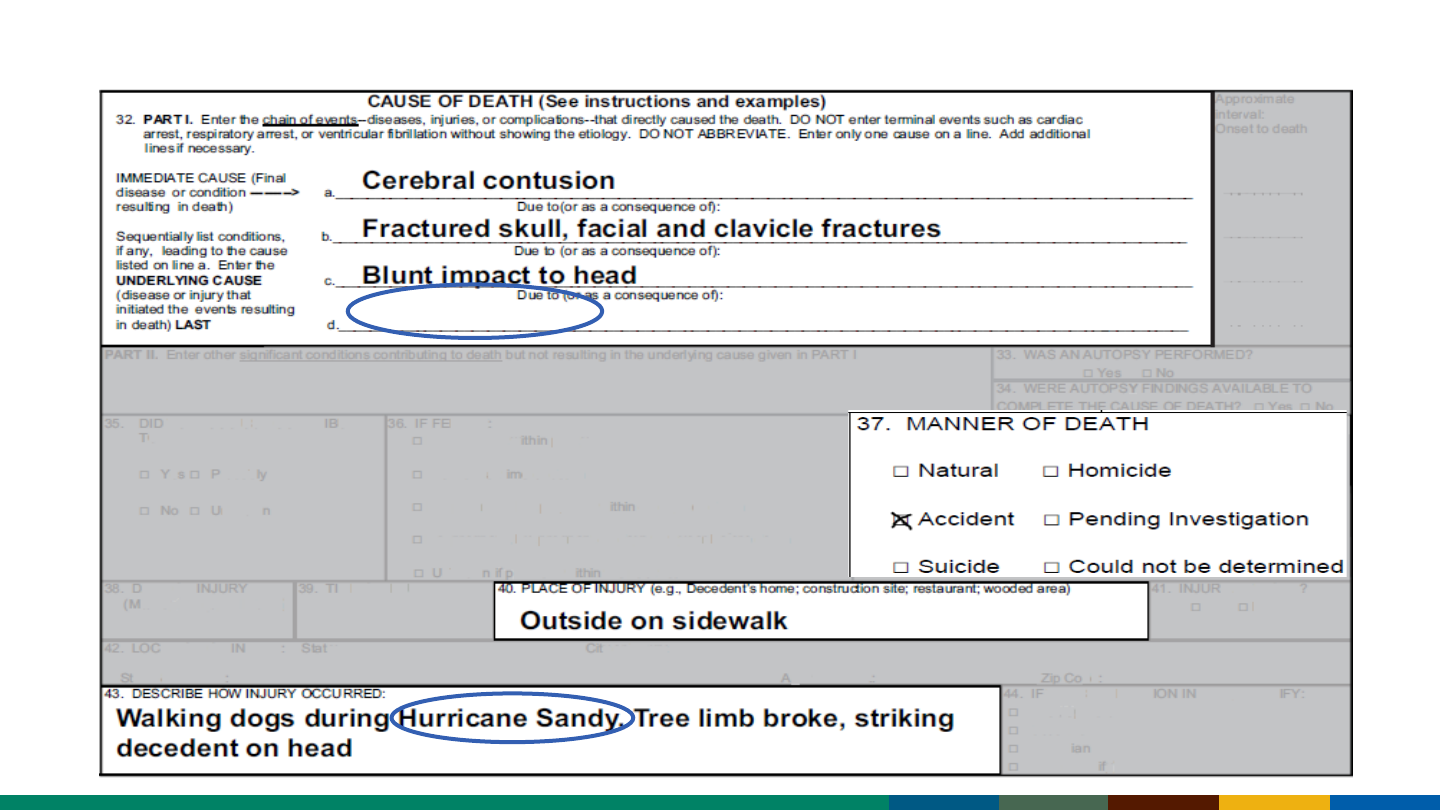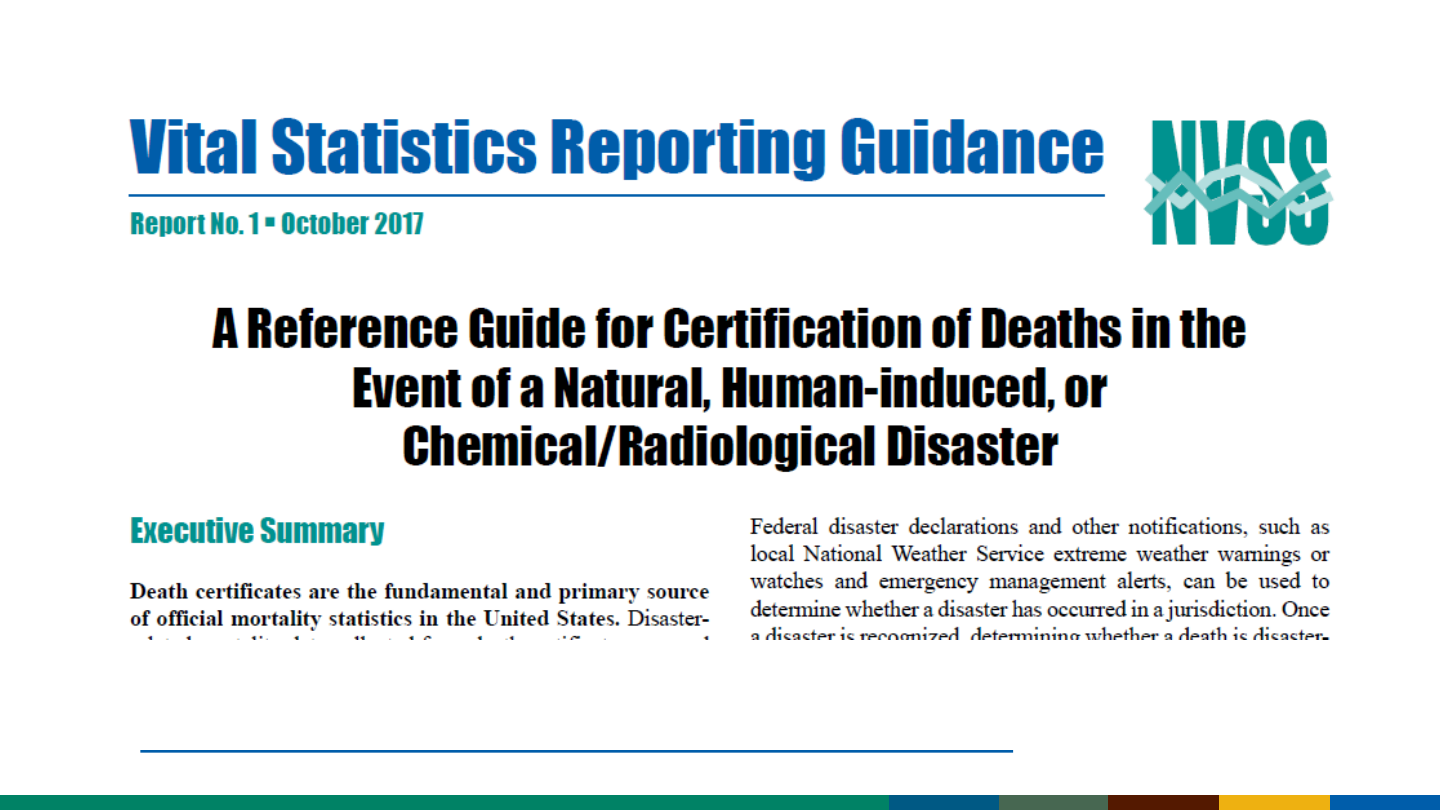
National Center for Environmental Health
Guidance for Certification of Deaths in the Event of a
Natural, Human-Induced, or Chemical/Radiological
Disaster
Tesfaye Bayleyegn, M.D., M.P.H.
Senior Service Fellow
Acting Senior Advisor for International Relations
Office of Health Studies, Section Chief
Centers for Disease Control and Prevention
National Center for Environmental Health
Division of Environmental Health Science and Practice

Overview
Importance of Disaster Mortality Data
Types of Disaster-related Deaths
Determining a Disaster-related Death
Completing the Death Certificate for Disaster-related Deaths
Extra Practice Exercises

Intended Audience
Primary
Medicolegal Death Investigators
Medical Examiners
Coroners
Physicians
Nurses
Justices of the Peace
S
econdary
Public health professionals
Emergency management
Vital Registrars
Medical students

Importance of Disaster Mortality Data

Disasters
A serious disruption of the functioning of society, causing widespread human,
material, or environmental losses that exceed the local capacity to respond
and calls for external assistance.
Natural Hazards
Human-induced Complex Emergencies
*Photos by iStock

Disaster Examples
Natural hazards:
– incidents such as hurricanes, forest fires, floods, tornados,
earthquakes, landslides, ice storms, and volcanic eruptions.
Human-induced disasters:
– result from human actions or technological failures such as industrial
explosions or chemical release (e.g., the Elk River Chemical spill in
West Virginia in 2014), chemical or biological contamination of the
environment such as oil spills like Deepwater Horizon, transportation
incidents, and disasters like the Flint Water Crisis.
Complex emergencies:
– emergencies that can be slow to take effect and can extend over a
l
ong period such as war, drought, and famine.

The Role of Death Certificates
Provide information on the different ways
disasters can lead to death
Provide critical, actionable data during
response and recovery activities
Help develop future prevention strategies to
reduce morbidity and mortality from disasters
Needed by families recovering from a disaster
Response
Urgent
Research
Non-Urgent

Disaster-related Mortality Surveillance
Primary data source: death certificates
Disaster mortality surveillance uses death certificate data to
– Assess the scope of a disaster incident
– Identify common risk factors for disaster-
related deaths
– Develop evidence-based public health interventions
Challenges from inconsistent reporting of disaster-
related death
– Difficult to generate reliable and accurate mortality statistics
• Difficult to identify the most frequent causes of death associated
wi
th disaster incident
• Difficult to estimate the disaster-related death toll

How do we identify disaster-related
deaths accurately?

Discrepancies in Reporting Disaster-related Deaths by
Different Sources
Disaster Red Cross FEMA
(Approved
Funeral
Expenses)
NOAA-
NWS
Storm
Data
Other
Agency
(EOC, ME)*
Vital Stats
(Search
w/o
names)
Hurricane
Harvey, TX
(2017)
75 70 60 94 69
Hurricane
Sandy, NJ
(2012)
34 61 12 75 24
April 27
Tornado, GA
(2011)
15 9 15 15 6
Hurricane
Ike, TX
(2008)
38 104 20 74 4
* EOC = Emergency Operations Center and ME = Medical Examiners Office

Potential Reasons for Discrepancies in Reporting
Disaster-related Deaths
Delays in reporting death data
Inconsistent reporting
Duplicate reporting
Incomplete information on the death certificate
Inaccurate coding of death records
Lack of sufficient death scene investigation information to attribute death
t
o the disaster

Types of Disaster-related Deaths

Direct and Indirect Disaster-related Deaths
Directly-related disaster death
– Caused by the forces of the disaster (e.g., strong wind) or direct
consequences of these forces (e.g., structural collapse, flying debris, or
radiation exposure)
Indirectly-related disaster death
– Disaster led to unsafe or unhealthy conditions (e.g., hazardous roads)
or a loss or disruption of usual services (e.g., power outage) that
contributed to the death

“But for” Principle
“But for the [disaster], would
they have died when they did?”

Common Causes of Directly-related Disaster Deaths*
Fire or smoke inhalation
Burns
Crushing
Drowning
Electrocution
Falls
Hyperthermia (heat)
Hypothermia (cold)
Radiation or chemical poisoning
Suffocation
Traumatic injury
Blunt-
force trauma
Penetrating injury
*Not an exhaustive list

Common Circumstances Leading to Indirectly-related
Disaster Deaths*
Loss/disruption of public utilities
Loss/disruption of transportation-
related services
Loss/disruption of usual access to
medical or mental healthcare
Preparation for disaster
Social disruption, including riots or
anarchy
Return to unsafe, unhealthy
structures or environment
Use of temporary sheltering or
provisions; displacement
Acute exacerbation of chronic
condition(s)
Cleanup after disaster
Escaping or fleeing the disaster
Evacuation
Exposure to industrial or chemical
ha
zards
Psychosocial stress or anxiety
*Not an exhaustive list

Determining a Disaster-related Death

Discrepancies Among Different States:
Designation of Deaths as being Related to a Disaster
• An 86-year-old man with lung cancer in
State #1
• Loss of electricity due to the hurricane
• Unable to use supplemental home oxygen
• Put on partially functioning ventilator in a
hospital
• Cause of death: Lung cancer
• No mention of relation of death to
hurricane
• 67-year-old woman with emphysema
in State #2
• Loss of electricity due to hurricane
• Unable to use supplemental home
oxygen
• Cause of death: Complications of
emphysema
• Relation of death to hurricane
documented
*Photos by iStock

Determination of Disaster-related Deaths
Flowchart
Step 1: Consider whether
the death occurred
during a disaster.
National Weather Service
Emergency management
official warnings or watches
Official alerts (e.g., state of
emergency, FEMA
declaration)
Step 2: If yes to Step 1, explore whether the
death was directly or indirectly related to
the disaster. Apply the evidence, including
the death scene investigation, autopsy, and
laboratory findings
.
Traumatic injury
Burn or smoke inhalation
Chemical or toxic exposure
Drowning
Electrocution
Hyperthermia or
hypothermia
Radiation effects
Suffocation
Evacuation
Loss or disruption of health,
utilities, or transportation
Preparation for disaster
Repair or cleanup activities
Returning to unsafe or
unhealthy environments or
structures
Step 3: If yes to Step 2, record
the disaster type and name
and circumstance of death on
the death certificate
This can be done in Part I, Part II, or in
the Describe How Injury Occurred field
(e.g., Hurricane Sandy, Joplin Tornado)
Physicians: Report all
suspected non-natural
deaths, including
disaster-related deaths,
to Medical Examiners,
Coroners, and Justices of
the Peace and contact
vital statistics

Key Questions for Disaster-related Consideration
Was the death caused by the actual forces of the disaster (e.g., wind, rain, flood,
earthquake, or blast wave) or by the direct consequences of these forces (e.g.,
structural collapse, chemical spill, or flying debris)?
– If so, this is a directly-related disaster death
Did the forces of the disaster lead to unsafe or unhealthy conditions that caused a
loss or disruption of usual services (e.g., utilities, transportation, environmental
protection, medical care, police/fire) AND did these losses or disruption contribute
to the death?
– If so, this is an indirectly-related disaster death
Did the forces of the disaster lead to temporary or permanent displacement,
property damage, or other personal loss or stress AND did these losses or
disruptions contribute to the death?
– If so, this is an indirectly-related disaster death

Disaster-related Deaths
Disaster-related deaths may occur
– Before the incident
– During the incident
– Immediately after the incident
– Months or years after the incident
Fatal occupation-related injuries
– Occur during the course of providing services
– Need to be documented on the death certificate

Disaster-relatedness of Poisonings and Natural Deaths
Chemical poisoning deaths can be disaster-related:
– Carbon monoxide poisoningassociated with generator use during
power outage
– Exposure to chlorine gas released from hurricane-damaged storage
tanks during repairs
Natural deaths can also be disaster-related:
– Exacerbated chronic conditions
• Asthma-
related deaths associated with wildfires
– Diabetic ketoacidosis from lack of insulin
– Cardiovascular incidents associated with hurricanes

Examples of Indirectly-related Disaster Deaths
An elderly person who has a heart attack after evacuating to a shelter
during a hurricane
A death resulting from a car crash that occurred while evacuating a storm
A person who dies after not receiving dialysis for several days because of
power outages after a hurricane
If unable to determine whether a death is disaster-related, but it’s likely or
probable that it might be, then still document the disaster type and name
and the circumstance of death on the death certificate.

Completing the Death Certificate for
Disaster-related Deaths

Who Should Certify Disaster-related Deaths?
Medical examiners/coroners/
justices of the peace (ME/C/JP):
– Deaths directly related to
disasters
– Deaths indirectly related to
disasters and due to injuries,
poisonings, and complications
thereof
Physicians
– Deaths that are indirectly-
related to disasters and due to
natural causes
Sudden or unexpected
death may need to be
referred to the ME/C.
When in doubt, consult the
ME/C

Filling out Part I
Cause of death disease(s) or conditions(s) reported as precisely as
possible
– Immediate cause (final disease or condition resulting in death) listed
on line “a”
– Sequentially list conditions leading to the immediate cause of death
– Underlying cause (disease or injury that initiated the incidents
r
esulting in death) on the last line
Report one incident on each line even if incidents occurred simultaneously
The disaster type and name can be included in Part I
– “Condition” can be circumstance of death and disaster name and type

Filling out Part I
Asthma
Smoke inhalation from Woolsey Wildfire
Asphyxia

Filling out Part II
Include other significant conditions or incidents contributing to death but
not resulting in the underlying cause.
– Contributing conditions do not have to be a disease.
Other conditions include clinical and non-clinical information.
Disaster type, name, and circumstance can be included in Part II.

Filling out Part II
Moore tornado

Filling out Part II – Natural Death Example 1
Chronic kidney failure
Type II Diabetes
Unable to receive dialysis for 6 days due to Hurricane Maria related power
outage at local treatment center.

Filling out Part II – Natural Death Example 2
Myocardial Infarction
Atherosclerosis
EMS unable to respond to 911 call due to flooded roads after Hurricane Matthew

Filling out “Describe How Injury Occurred” Box
Circumstances surrounding the injury or external cause of death
Details depend on the type of injury and disaster involved
– Example: Drowned in a flooded residence during Hurricane Ike
s
torm surge
Work related injuries
– Mark “Yes” in the “Injury at work?” field
Enter “Place of Injury” if known
Include disaster name and type as well as circ
umstance of death

Filling out Describe How Injury Occurred Box
Car crashed into tree
, Hurricane Ike

Discussion Scenario A: Landslide at Construction Site
A landslide occurred near a local construction site where a road was being
built 4 miles outside of Oso, Washington. The Fire and Rescue team found the
body of a 29-year-old male buried under five meters of earth. The decedent
was confirmed to be one of the construction workers.
Is this death disaster-related?
– Answer: Yes
What disaster-r
elated data would you include on the death certificate?
– Answer: Disaster type and name should be included in Part I, disaster
type, name, and circumstance of death should also be included in the
“Describe how injury occurred” box.

Scenario A: Death Certificate
Hemothorax and hemoperitoneum
Crushed chest and abdomen
Oso, Washington landslide
Construction Site
Construction worker found buried under 5 meters of earth after March
2014 Oso landslide in Washington

Scenario B: Disaster-related Chemical Exposure
A 33-year-old asthmatic worker at a water treatment facility developed
respiratory distress and died at a hospital after being exposed to chlorine when
a pipe leading from a chlorine tank cracked during the Northridge, California,
earthquake, according to the medical record. Emergency management reports
confirm that the chemical release was caused by the earthquake.
Is this death disaster-related?
– Answer: Yes
What disaster-r
elated details would you include on the death certificate?
– Answer: Chemical name and disaster type and name should be
reported in the cause of death section. Disaster type, name, and
circumstance of death should be reported in the “Describe how injury
occurred” box. Check “yes” for “Injury at work.”

Scenario B: Death Certificate
Asthma, Northridge, California earthquake

Scenario C: Carbon Monoxide Poisoning During
Natural Disaster
A 39-year-old female died during Hurricane Sandy in her home. The storm
caused a regional blackout and she had used charcoal in her fireplace for
heat. According to emergency medical services (EMS) officials, high carbon
monoxide (CO) levels were detected in the home.
Is this death disaster-related?
– Answer: Yes
What disaster-r
elated details would you include on the death certificate
and where would you document them?
– Answer: Disaster type and name and circumstance of death should
be included in Part II and in the “Describe how injury occurred” box

Carbon Monoxide (CO) Poisoning Notations
SOURCE OF CARBON MONOXIDE: Gas range, generator, charcoal grill
LOCATION OF THE SOURCE: Basement, outside near window, house,
garage, automobile
CIRCUMSTANCE(S): Indicate if the carbon monoxide death is disaster-
related and the circumstances (e.g., power outage, using alterative heat
source during snowstorm, no carbon monoxide detector in home).
MANNER: Consider intentional poisoning.

Scenario C: Death Certificate Example
Source of carbon monoxide
Location of the source
Circumstance(s)
Manner
Hurricane Sandy

Scenario D: Human-induced Incident
A 39-year-old male was within 4 miles of an improvised nuclear device that was
detonated near a construction site in a major metropolitan area. The incident
was confirmed by the local emergency manager and FBI as an act of terrorism.
The decedent was exposed to a radiation dose of 8 grays (800 rem) as a result of
prompt radiation and radioactive fallout. He also had minor traumatic injuries
and thermal burns on 15% of his total body surface area. He self-evacuated to a
hospital 50 miles away. He developed acute radiation syndrome, starting with
intractable vomiting approximately 1 hour after the explosion, followed by bone
marrow depletion of granulocyte progenitors on day 2 of hospitalization. He
survived for 23 days before dying from gram-negative sepsis, despite receiving
granulocyte colony-stimulating factors, broad-spectrum antibiotics, and multiple
transfusions.

Scenario D: Death Certificate Example
Intentional detonation of a nuclear device by another person
as an act of terrorism
Terrorism: nuclear device detonation

Scenario D: Comments
Energy from the detonation of a nuclear weapon is released as a blast,
extreme heat, prompt radiation, and delayed radiation in fallout.
Initial deaths would occur at or near ground zero from
– Blast injuries
– Heat or thermal injury
– Prompt radiation injury
Delayed deaths m
ay occur from
– Initial blast injuries
– Acute radiation syndrome

Key Points for Disaster-related Death Certification
Be aware of natural and human-induced disaster incidents
Consider causes of death that can be indirectly-related to the disaster
Identify all disaster-related deaths
– Deaths can occur before, during, and after a disaster.
– For example, trauma from a car crash when exceeding the local
c
apacity to respond while evacuating, drowning during a flood, cancer
from significant radiation exposure
Record the disaster type, name, and circumstance of death on the death
certificate
– Part I, Part II, or “Describe How Injury Occurred” box (if applicable)

Extra Practice Exercises

Scenario I: Tornado Incident
EMS reported that a 13-year-old female fell during the Moore tornado
outbreak in Oklahoma. Her family witnessed her running down wooden
basement stairs to escape the impending tornado. She fell approximately 15
steps headfirst, resulting in right parietal epidural bleed and skull fracture.
Is this death disaster-related?
– Answer: Yes
What disaster-r
elated data would you include on the death certificate?
– Answer: Disaster type and name and circumstance of death should be
included in Part II and the “Describe How Injury Occurred” box

Scenario I: Death Certificate
Fall from stairs
Moore tornado
Fall

Scenario II: Hurricane Incident
A 28-year-old male died when a tree fell on him during Hurricane Sandy. He
suffered multiple traumas, including a fractured skull causing cerebral
contusion. Emergency medical service and police reports indicated he
thought the hurricane had passed and was walking his dogs.
Is this death disaster-related?
– Answer: Yes
What disaster-r
elated details would you include on the death certificate
and where would you document them?
– Answer: Disaster type and name and circumstance of death should
be included in Part I and the “Describe How Injury Occurred” box

Scenario II: Death Certificate Example
Hurricane Sandy

Scenario III: Extreme Winter Cold and Chronic Conditions
An 85-year-old male with a history of Alzheimer’s disease and arteriosclerosis
died from hypothermia after he wandered away from his home for an hour
during a severe 2012 Nor’easter snowstorm, reported by local news.
Is this death disaster-related?
– Answer: Yes
What disaster-r
elated details would you include on the death certificate
and where would you document them?
– Answer: Disaster type and name and circumstance of death should
be included in Part I and “Describe How Injury Occurred” box

Scenario III: Death Certificate Example
Nor’easter snowstorm

Scenario IV: Bombing or Blast Deaths
A 41-year-old firefighter responded to a 911 call at the starting line of the
Hawaii Ironman racing incident, where an improvised explosive device went
off. After she arrived, a second device was detonated, and the firefighter
sustained fatal abdominal trauma. The incident was confirmed by the local
emergency manager and local FBI to be an act of terrorism. She died
immediately at the scene of abdominal hemorrhage from her wounds.
Is this death disaster-related?
– Answer: Yes
What disaster-related details would you include on the death certificate and
where would you document them?
– Answer: Disaster type and name and circumstance of death should be
included in Part I and the “Describe How Injury Occurred” box

Scenario IV: Death Certificate Example
Terrorism

Conclusion
This training is important to:
– Improve the accuracy and completeness of information on the death
certificate.
– Ensure greater consistency for capturing disaster-related deaths
before, during, and after a disaster by providing guidance that will aid
in ensuring disaster-relatedness is reflected appropriately on the
death certificate.

Thank you for participating in this training.
Tesfaye Bayleyegn, M.D., M.P.H.
Email: [email protected]v
Phone: (770) 488-3467
For more information, contact NCEH
1-800-CDC-INFO (232-4636)
TTY: 1-888-232-6348 www.cdc.gov
Follow us on Twitter @CDCEnvironment
The findings and conclusions in this report are those of the authors and do not necessarily represent the
official position of the Centers for Disease Control and Prevention.

